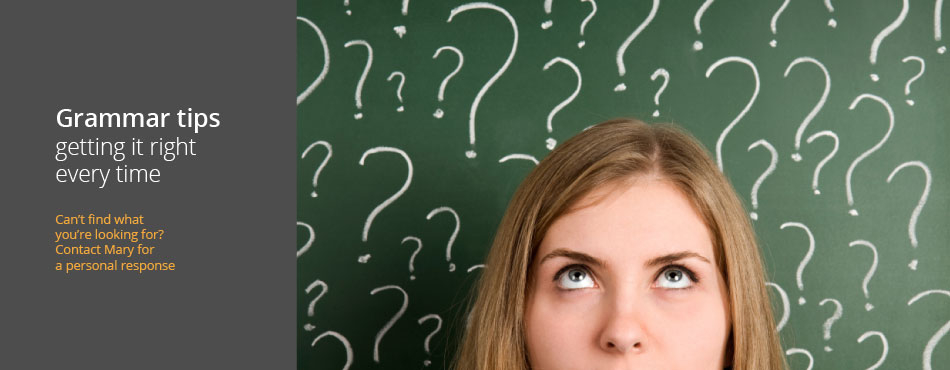By Mary Morel | May 2016
Capital letters in titles and headings
There are two ways of using capital letters in titles and headings:
- In title case, the first and last words, proper nouns (name of people and places) and ‘important’ words have initial capitals. (‘Important’ words are nouns, pronouns, verbs, adjectives, adverbs and some conjunctions.)
The Art of Painting Portraits in Australia
- In sentence case, the first word and proper nouns have initial capitals.
The art of painting portraits in Australia
In Australia and New Zealand, titles of business documents, Acts and books are usually in title case, and headings and subheadings are in sentence case. Subheadings in titles are also often in sentence case (Write to Govern: How to write effective board papers). I notice that American writers tend to use title case in headings and subheadings.
In Australia, there is one notable exception. The government style guide’s title is in sentence case (Style manual), presumably to emphasise the shift towards sentence case. It uses sentence case for subheadings throughout the manual, which I like, but I think the title should be Style Manual!
I prefer sentence case for headings and subheadings because:
- Writers tend to be inconsistent in their capitalisation when they use title case – a word will be capitalised in one heading, but not in the next
- Knowing what words to capitalise is not straightforward
Two major American style guides, The Chicago Manual of Style and AP Style don’t agree about capitalising prepositions (e.g. to, for, between). The Chicago Manual of Style recommends lower case for all prepositions regardless of length, whereas AP Style recommends capitalising all words of four letters or more. (The Chicago Manual of Style makes an exception for prepositions used adverbially or adjectivally, for example, Talk Up Your Business).
Which do you prefer?
The Light Between Oceans
The Light between Oceans
Style guides also don’t agree about whether to capitalise the second word of a hyphenated compound (‘Self-respect’ or ‘Self-Respect’).
No wonder capitals are tricky!
Read more about title case.
I cover capital letters in three of my online courses: An A to Z of Punctuation, Biz Grammar and Styles for Business Writing.
Next month I’ll write about initial capitals used to indicate respect and in job titles.
Readers’ questions
Punctuation with brackets
Question: Can you please write about the placement of punctuation inside and outside brackets.
Answer: This sometimes confuses me too. The punctuation varies depending on whether you are adding a sentence fragment or a complete sentence. And even then there are no hard and fast rules!
Sentence fragments
Sentence fragments are easier because you start them with lower case and don’t usually have a final full stop within the brackets. You always need end punctuation for the whole sentence.
The large intestine (also called the colon or large bowel) is the last part of the digestive system.
Occasionally, you may use a question mark or exclamation mark within the brackets.
It was your fault (wasn’t it?).
Complete sentences
When we add complete sentences in brackets within a sentence, we usually use normal sentence punctuation. But not always! Sometimes you can add a complete sentence starting with a lower case letter and ending with an exclamation mark or question mark. Whatever style you choose, you still need punctuation at the end of the sentence.
Google restructured its business to avoid tax penalties (It’s true!).
Google restructured its business to avoid tax penalties (it’s true!).
Google restructured its business to avoid tax penalties (it’s true)!
Jane Strauss, GrammarBook, has written about this topic in more detail.
Subjunctive
Question: What tense should I use in the following sentence?
With that, X disappeared and Y ran as if he were being pursued.
With that, X disappeared and Y ran as if he was being pursued.
Answer: Either sentence is correct depending on whether you care about the subjunctive (were). The subjunctive describes wishful or hypothetical action. Some people think the subjunctive is on its deathbed. Read my blog about the subjunctive.
By the way, we’re discussing mood here, not tense. In grammar, mood conveys the writer’s attitude and there are three types of mood: indicative, imperative and subjunctive. Read more about mood.
My recent blogs
My recent blogs:
- What does ‘write for your audience’ mean?
- How to write recommendations in board papers?
- Adding extra information to sentences
Interesting stuff about writing
Bumfuzzle, Cattywampus, Gardyloo & More
Take a look at Merriam-Webster’s top 10 funny sounding words (e.g. collywobbles)
It’s time to re-learn the lost art of reading
Reading can help with financial investments. Read more.
Free books
Many Books offers lots of free and discounted ebooks.
Study: Poor writing skills are costing business billions
It comes as no surprise to me that businesses are spending a fortune improving writing skills. Good writing is not valued enough. Read more.
New Yorker cartoon
Just take a look and smile!
Quote of the month
People who think well, write well
David Ogilvy, founder of Ogilvy & Mather



